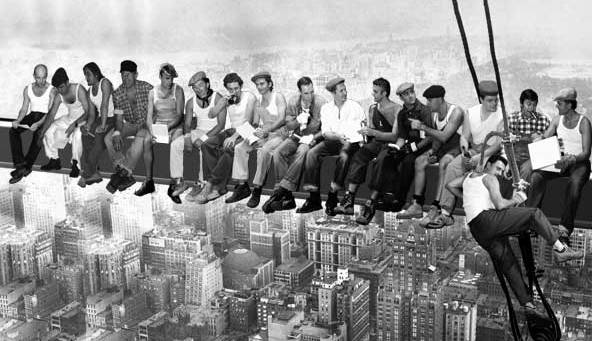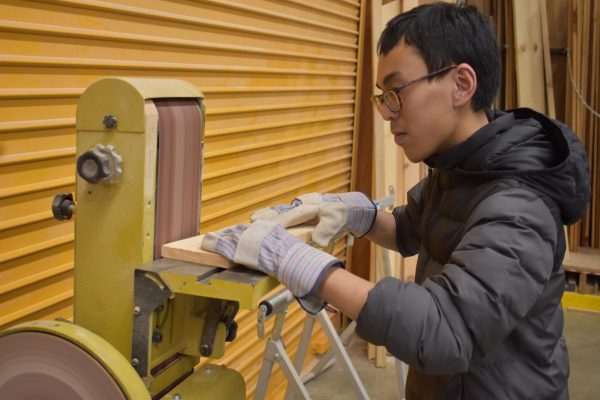OPINION: Immigrants are the backbone of America

“Lunch atop a Skyscraper” is a photograph of 11 immigrant men that represents a pioneering and expansionist era in American history.
“Lunch atop a Skyscraper” is an iconic photo from American history. It depicts 11 daring men clad in rundown work clothing and scraggly overalls, sitting on the steel girders of Manhattan’s Rockefeller Center. J.D. Rockefeller’s daring industrial center, at the time, was only under construction. These men braved a fall to certain death for their abysmal paychecks.
Photographer Charles C. Ebbets was hired by the Rockefeller Center to take the photo that was staged as a publicity stunt. Despite its manipulation, the photo remains representative of a vastly pioneering and expansionist era in American history.
Based on industrialization, the fire of red-hot furnaces, the miracle of steel and railroads, America became a country of power and machinery, polluted in a cloud of smoky black billows. Tycoons such as J.D. Rockefeller, Andrew Carnegie, J.P Morgan and Henry Ford earned millions off of this revolution. Behind the success of any well-off man, however, lay the blood, sweat and tears of the truly adventurous workers that built America.
Even though it was staged, “Lunch atop a Skyscraper” showcases real workers. Yet there were more to these workers than what meets the eye. Several were Irish, others were Italians, one was a Polish man and one was a Greek worker. These men at lunch were not Americans, but they were more American than the capitalists who exploited them. These men were made into icons of a new America, but the shame is in what came decades after they lived. The heroes of this age were the immigrants who built this country.
In Santa Clara’s backwoods lies San Francisco, arguably the most prolific of the Pacific’s vast industrial cities. From the late 19th century into the turn of the 20th century, San Francisco saw unprecedented growth in population and size. Part of this change was aided by the California Gold Rush and the Pacific Railroad in the mid-19th century. The other came as a result of immigration.
Immigrants came in through Angel Island, looking for a better life in the brick factories of San Francisco. Census 35, a California census, revealed that most were European: Britons, Irishmen, Italians and Greek Hellenes. Other immigrants were primarily Chinese and Japanese. In little ethnic enclaves, these immigrants built their cultures and the foundations of which remain in modern day, granting San Francisco the ethnic and cultural diversity it is known for. The 2021 Census found that San Francisco is one of the most diverse cities in America, partly due to the 20th century’s period of mass immigration. Life, however, was not easy for these migrants.
Their tenements were crowded, filled to the brim with squalor and lacking basic human needs. Societal problems ran far out of their home lives. In the Progressive Era, at the turn of the 20th century, nativists – individuals who favored native inhabitants over immigrants – believed that non-Americans were bringing the worst of socialism, anarchism, crime and foreign religions from their home countries. Every day, immigrant men and women filled deadly industrial factories, clocking in and contributing to San Francisco’s chemical and textile production revolution, not knowing if they would return home.
21st century America, however, has offered these immigrants the status of heroes and as worldbuilders. This greatly takes the liberty out of their suffering and what their people went through. When help and reform could have been granted to lessen their suffering, America’s culture directly profited from the work of immigrant men and women.
Part of the reason for this mockery of immigrants’ struggles lies in Modernism, a cultural movement with its roots in modernity and industrialization, capturing themes of urbanization and technological growth. Migration can be considered a runoff of modernization. The art movements of Modernism transplanted itself into the culture of the time with art forms such as the Ashcan School of New York actively working around capturing still and desolate subject-matters.
As seen in Ebbet’s classic “Lunch atop a Skyscraper,” Tessel Baudin of the University of Amsterdam noted how Americans at the time ignored their daringness, dismissing the workers as Irishmen. Rockefeller’s workers were actively suffering, yet the focus of their iconic photo lies on the erecting of the grand Rockefeller Center.
Modernism glorified progress and its runoffs. As the Modernism movement gradually faded out in American society, the legacy left by photos such as “Lunch Atop A Skyscraper” generally changed. The photo became about the workers and their daringness. Their status as immigrants became something to be celebrated and applauded.
In transition from the turn of the 20th century to the mid-century, Americans looked back and remembered the Progressive Era as an actually progressive time in history, rather than the nativist mess it was. A cheap erasure of the cultural legacy of immigrants’ struggles is demeaning and its modern day runoffs are still damaging. The root of the issue lies in the comparison of 20th century immigration to the legacy of 21st century migration.
Currently, politics capitalizes off of the United States-Mexico border crisis. Mark Hugo Lopez, director of race research for the Pew Research Center, found that nearly a quarter of America’s first-generation immigrants are from Latin America, coming both legally and illegally, through America’s southern border.
Like 100 years ago, these immigrants are being pushed out of their countries by poverty and violence. And just like 100 years ago, they are being drawn to America for safety and job opportunities.
El País, a national Spanish news source, found that the average Mexican migrant makes $22,000 a year, standing well below the required amount of California’s progressive minimum annual salary of around $30,000 to $40,000. Most Latin immigrants are below the poverty line as construction workers, or working tirelessly in fields and factories, in some of society’s hardest jobs.
Similar to the immigrants of the 20th century, Latin migrants faced much societal scrutiny. Donald Trump’s 2016 Presidential campaign, for example, was electrified by the soon-to-be President’s nativist politics. Republicans screamed for a wall to be built at the southern border and to deport the millions of Latin Americans who were working diligently and loyally. The Republican Party that has sold its voters a lie of an immigrant invasion has turned upon its own party’s ideals.
The nativists of the Progressive Era were not Republicans. In the early 1900s, the Republican Party attracted immigrants for their pro-business stance. For a party that once celebrated the transplant of foreign labor into America’s economy, they have fallen hard into a trap of nativist politics.
American culture glorifies and reveres the 20th century immigrant as a builder of worlds and as the cornerstone of America. Yet the modern day immigrant has become unpopular and scrutinized. Americans are ignoring their cultural legacy with their nativist politics.
America has maintained a cultural ethos as the land of liberty and freedom, and it has attracted millions of immigrants who have built this country. For one reason or another, American politics has turned against its own culture’s roots. Politics nowadays aims to maintain the status quo rather than offering a promise of better times and days. Perhaps this is the reason why Americans have turned against their own cultural legacy.
Immigrants are an important part of America. There would be no America without immigrants. The millions of Latin folk who are pouring into this country are searching for a better life and to enrich it with their own cultures, much like Italians, Germans, Irishmen, Slavs, Britons, Nords and Greek Hellenes did just over a century ago.
The day of the immigrant never ended. They just became Americans.















